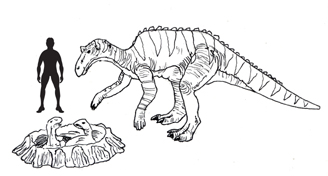The First Dinosaurs in Space
As today, April 12th is the 50th anniversary of the first human space flight, we at Everything Dinosaur thought it best to catch the mood by discussing briefly dinosaurs in space. Yes, dinosaurs have been into space, at least the fossils of two dinosaurs that is.
Dinosaurs and Spaceflight
On this day in 1961 Yuri Gagarin, a Russian cosmonaut, became the first human in space and the first to orbit the Earth. His space craft, called Vostok 1 made the historic 108 minute venture into space on this day fifty years ago. The flight took place in the morning with a launch around 9am local time. This would have meant that this epic journey, the start of the space race between the USA and the Soviet Union, began in the early hours of the morning in the United Kingdom around 6am. We suspect that this event was not widely known until the evening. After all, there was not the blanket news media that we have today around half a century ago.
However, dinosaurs have made it into space, but not until the mid 1980s, where as part of the United States space programme a fossil of an ornithopod called Maiasaura (Maiasaura peeblesorum) went up into space. Maiasaura was a large hadrosaur (member of the hadrosaurine group of duck-billed dinosaurs – distinguished by their lack of adornments and head crests). It was discovered by the American palaeontologist John Horner in 1978 and officially named a year later.
The remains of this dinosaur have been found in western Montana, in the Late Cretaceous rocks of the Two Medicine Formation. Few dinosaurs left traces behind providing clues as to how these animals lived and behaved, however, Maiasaura is a definite exception to this. Over 200 individual skeletons have been unearthed to date, from hatch-lings right up to mature adults. Jack Horner and his team discovered a Maiasaura nesting site that has yielded a great deal of information about how this type of dinosaur raised its young.
“Good Mother Lizard”
It seems that Maiasaura looked after its babies (the name means “Good Mother Lizard”), very apt in this dinosaur’s case. Fossils recovered from the nesting site, show that these animals made nest mounds out of mud, and may have covered any eggs laid with vegetation to keep them warm. Hatch-lings that have been fossilised show teeth wear but their legs are not fully formed (undeveloped legs is feature seen in the chicks of many birds). This indicates that the babies were fed at the nest, as they were unable to forage for themselves. It can be surmised from this data that the parents looked after the youngsters to a degree. The nesting site seems to have been vast, with many thousands of animals at the site, this indicates that Maiasaura lived in large herds, or at least congregated at communal nesting sites.
An Illustration of Maiasaura

“Good Mother Lizard”. Maisaura fossils have been sent into space. Picture credit: Everything Dinosaur
Picture credit: Everything Dinosaur
Maiasaura’s other claim to fame is that this dinosaur was the first to be taken up into space. A piece of fossilised bone from a baby Maiasaura along with a piece of Maiasaura eggshell was taken into space by astronaut Loren Acton on a NASA mission in 1985. Not a bad record for Maiasaura, being totally unknown just 7 years earlier, and then the first dinosaur in space. The second dinosaur to travel in space was the skull of a Coelophysis, (Triassic theropod). The skull was sent into space on the US space shuttle Endeavour on 22nd January 1998. It travelled to the Mir space station, one of a number of trips made by space shuttles to the orbiting station in the Shuttle-Mir programme.
For models of ornithopods including many members of the hadrosaur lineage: PNSO Age of Dinosaurs Figures.
The Reptilia Class in Space
Dinosaurs were not the first representatives of the Class Reptilia to travel in space. Tortoises were used in some of the research programmes as manned space flight was being developed. The first tortoise in space was launched by the Soviet Union in September 1968, as part of the research programme monitoring the potential effect of long space flight on humans.
Tortoises were ideal “guinea pigs” for such experiments, due to their ability to survive hostile conditions and to live on little food and water, characteristics recognised by early explorers on Earth, who often sailed with tortoises and turtles on board ship to provide a source of fresh meat into the journey. We have no record of what happened to this particular tortoise after the capsule in which it had travelled returned to Earth.
As far as we can tell no adult birds have been sent up into space. Chicken embryos were sent up into space as part of an experiment kit to test the development of chicks in zero gravity by the Americans in 1989. This particular experiment had been scheduled to take place three years earlier but it was lost when the space shuttle Challenger exploded shortly after launch on January 28th 1986. Other fertilised bird’s eggs have been sent into space on subsequent occasions, no birds as far as our research shows. It would be fascinating to find out how birds cope with zero gravity. Effectively, once in motion they would not need to flap their wings, perhaps they could use their wings to stabilise themselves as they were subjected to zero G.






Leave A Comment